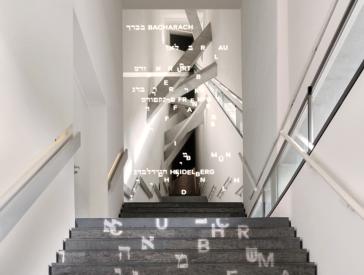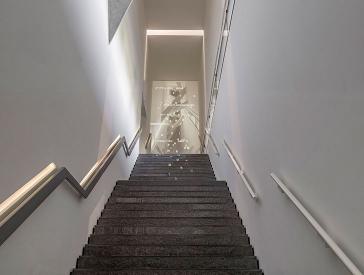
20 Years of the JMB
20 Interviews
In 2021 the Jewish Museum Berlin is celebrating its 20th anniversary. After two eventful decades, we are looking back and ahead with some of the people who have accompanied us along the way. What is their connection to the JMB? What are their favorite objects? Our interviewees also take a look at the world today and our joint future. What role do museums play in our society? What future do they want for Jewish life in Germany?
-
Shelly Kupferberg, Journalist & Radio Host
Read more -
Lia, School Student
Read more -
Daniel Libeskind, Architect
Read more -
Max Czollek, Author & Curator
Read more -
Iris Berben, Actress
Read more -
Barrie Kosky, Opera and Theater Director
Read more -
Josef Schuster, President of the Central Council of Jews in Germany
Read more -
Mirna Funk, Author & Journalist
Read more -
Peter Schaul, Donor
Read more -
Charlotte Knobloch, President of the Jewish Community of Munich and Upper Bavaria
Read more -
Ulrich Matthes, Actor
Read more -
Sharon, Musician
Read more -
Yasna Aksenova, Member of the Friends of the JMB
Read more -
Navot Miller, Artist
Read more -
Ricarda, School Student
Read more -
Anastassia Pletoukhina, Sociologist
Read more -
Georg Liebich, Social Worker
Read more -
Valentin Lutset, Artist & Activist
Read more -
Tal Alon, Founder of SPITZ Magazine
Read more
Shelly Kupferberg
Shelly Kupferberg, a journalist and radio host from Berlin, believes it is important for museums to reach out to everyone, regardless of their level of knowledge. She is amazed at how the architecture of the Libeskind building tells a story at every bend, and admits she would love to play her flute in the building.
Lia
Lia, a school student from Berlin, reveals what she would do alone in the museum at night in and why she finds it important for young people to learn about Judaism.
Daniel Libeskind
The architect Daniel Libeskind discusses the turbulent genesis of the building during the period of German reunification, and explains how museums connect people in their function as social spaces.
Max Czollek
Author and curator Max Czollek talks about a flash mob approach to exhibition organization and the discourse on diversity in Judaism and beyond. What kind of society do you want for the future?
Iris Berben
“Take a stance!”
is actress Iris Berben’s appeal to all of us. In this interview you will learn what she means by this and why she and the Jewish Museum Berlin have been “friends” for years.
Barrie Kosky
“The JMB is part of the contemporary DNA of Berlin,”
says Barrie Kosky, artistic director and intendant of the Komische Oper Berlin. He believes museums should be places that not only impart knowledge, but, most importantly, initiate a dialogue with people and the city by asking important and even difficult questions.
Josef Schuster
Josef Schuster, president of the Central Council of Jews in Germany, has known the JMB since its founding. In his view, the cross section of Jewish life presented in the new core exhibition is remarkable.
Mirna Funk
“It marked the start of new Jewish life in Berlin,”
says the author and journalist Mirna Funk about the JMB. In this interview you will learn why she sees the JMB as an opportunity to teach people about Jewish life and history, and why she nevertheless questions the sense of Jewish museums in general.
Peter Schaul
Peter Schaul has donated many objects from his parents’ estate to the JMB. During the Nazi period, they were forced to flee Nazi Germany to France. In this interview he discusses his favorite object in the exhibition and why museums are important for our self-image.
Charlotte Knobloch
Charlotte Knobloch is a Holocaust survivor herself who currently serves as president of the Israelitische Kultusgemeinde München und Oberbayern. In this interview she explains why it is important for Jewish life, culture, and history to remain visible in the German capital, and the hopes she holds for future generations.
Ulrich Matthes
The actor Ulrich Matthes has followed the development of the JMB since its inception. In this interview he discusses culture as a basic human need, the museum’s vibrancy, and Wednesdays as “Human Kindness Day.”
Sharon
The rapper Sharon makes a self-confident appeal to her fellow human beings: “Be yourselves! Jewish life exists here. It’s okay to show it.”
In this video you will learn why she gets goosebumps when thinking about the JMB, and how she would celebrate with her friends in the museum.
Yasna Aksenova
Yasna Aksenova is a committed member of the Friends of the JMB. She finds it important to show the diversity of Jewish life and create meeting places for people with different views and from different social environments.
Navot Miller
More homosexuality, queer culture, and nudity — that’s what the artist Navot Miller expects from the JMB in the next 20 years. Additional topics in this interview: young people, integration as a two-way process, and pink fabrics.
Ricarda
Ricarda, a 15-year-old school student, talks about what she would do at night in the JMB, the extent to which museums inspire reflection and discussion, and why she thinks it is important for them to preserve knowledge for future generations.
Anastassia Pletoukhina
The sociologist Anastassia Pletoukhina has participated in exhibitions at the JMB. She finds it particularly important for the museum to serve as a place of encounter and discussion, and she welcomes the fact that the vibrant Jewish community is strongly represented in its new core exhibition — partly in the form of many of her friends and acquaintances.
Georg Liebich
The social worker Georg Liebich explains why he is so enthusiastic about the archive workshops, how the Garden of Exile makes him feel, and why the act of remembering and talks with people who have lived through history are so important.
Tal Alon
“Surprise me, please!”
is Tal Alon’s request of the JMB. Tal, who was born in Israel, is the founder and editor of the Hebrew-language magazine SPITZ. She currently lives in Berlin and has been involved in several projects at the JMB. She describes the museum as “symbolic,” “prominent,” and “controversial.”

